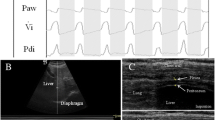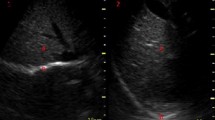Abstract
The diaphragm is the main respiratory muscle. Its contractile function can be adversely affected by several mechanisms including infection, surgery, trauma, nutritional deficiencies, metabolic derangements, and prolonged mechanical ventilation. Monitoring of diaphragmatic motion and contractile force can be used to estimate respiratory function and also to identify patients at risk of developing acute postoperative respiratory distress and predicting weaning failure. Unfortunately, clinical monitoring is currently poor in this field and neither sensitive nor specific. Several technical challenges remain to be overcome, with regard to pressure assessments and electrical measurements of muscle activity. Imaging evaluation using CT and ultrasound of the diaphragm wall motion and size is currently under investigation. The future will likely combine ultrasound evaluation of diaphragm motion and thickness along with a simultaneous evaluation of the electrical activity of the diaphragm in order to clinically monitor respiratory function in real time.
Access this chapter
Tax calculation will be finalised at checkout
Purchases are for personal use only
Similar content being viewed by others
References
Hermans G, De Jonghe B, Bruyninckx F, Van den Berghe G. Clinical review: critical illness polyneuropathy and myopathy. Crit Care. 2008;12(6):238.
Hussain SN, Mofarrahi M, Sigala I, Kim HC, Vassilakopoulos T, Maltais F, et al. Mechanical ventilation-induced diaphragm disuse in humans triggers autophagy. Am J Respir Crit Care Med. 2010;182(11):1377–86.
Jaber S, Petrof BJ, Jung B, Chanques G, Berthet JP, Rabuel C, et al. Rapidly progressive diaphragmatic weakness and injury during mechanical ventilation in humans. Am J Respir Crit Care Med. 2011;183(3):364–71.
Levine S, Nguyen T, Taylor N, Friscia ME, Budak MT, Rothenberg P, et al. Rapid disuse atrophy of diaphragm fibers in mechanically ventilated humans. N Engl J Med. 2008;358(13):1327–35.
Diehl JL, Lofaso F, Deleuze P, Similowski T, Lemaire F, Brochard L. Clinically relevant diaphragmatic dysfunction after cardiac operations. J Thorac Cardiovasc Surg. 1994;107(2):487–98.
Kim SH, Na S, Choi J-S, Na SH, Shin S, Koh SO. An evaluation of diaphragmatic movement by m-mode sonography as a predictor of pulmonary dysfunction after upper abdominal surgery. Anesth Analg. 2010;110(5):1349–54.
American Thoracic Society/European Respiratory Society. ATS/ERS Statement on respiratory muscle testing. Am J Respir Crit Care Med. 2002;166(4):518–624.
Mier-Jedrzejowicz A, Brophy C, Moxham J, Green M. Assessment of diaphragm weakness. Am Rev Respir Dis. 1988;137(4):877–83.
Beaussier M, El’ayoubi H, Rollin M, Parc Y, Atchabahian A, Chanques G, et al. Parietal analgesia decreases postoperative diaphragm dysfunction induced by abdominal surgery: a physiologic study. Reg Anesth Pain Med. 2009;34(5):393–7.
Banner M, Blanch P, Kirby R, Miller R. Respiratory care. In: Atlas of anesthesia, vol. 1. New York: Current Medicine; 2002.
Jung B, Constantin JM, Rossel N, Le Goff C, Sebbane M, Coisel Y, et al. Adaptive support ventilation prevents ventilator-induced diaphragmatic dysfunction in piglet: an in vivo and in vitro study. Anesthesiology. 2010;112(6):1435–43.
Jung B, Sebbane M, Goff CL, Rossel N, Chanques G, Futier E, et al. Moderate and prolonged hypercapnic acidosis may protect against ventilator-induced diaphragmatic dysfunction in healthy piglet: an in vivo study. Crit Care. 2013 Jan 24;17(1):R15.
Sinderby C. Neurally adjusted ventilatory assist (NAVA). Minerva Anestesiol. 2002;68(5):378–80.
Bordessoule A, Emeriaud G, Delnard N, Beck J, Jouvet P. Recording diaphragm activity by an oesophageal probe: a new tool to evaluate the recovery of diaphragmatic paralysis. Intensive Care Med. 2010;36(11):1978–9.
Lerolle N, Guerot E, Dimassi S, Zegdi R, Faisy C, Fagon JY, Diehl JL. Ultrasonographic diagnostic criterion for severe diaphragmatic dysfunction after cardiac surgery. Chest. 2009;135(2):401–7.
Grosu HB, Lee YI, Lee J, Eden E, Eikermann M, Rose K. Diaphragm muscle thinning in mechanically ventilated patients. Chest. 2012 [Epub ahead of print].
Author information
Authors and Affiliations
Corresponding author
Editor information
Editors and Affiliations
Rights and permissions
Copyright information
© 2014 Springer Science+Business Media New York
About this chapter
Cite this chapter
Jung, B., Coisel, Y., Jaber, S. (2014). Monitoring Diaphragmatic Function. In: Ehrenfeld, J., Cannesson, M. (eds) Monitoring Technologies in Acute Care Environments. Springer, New York, NY. https://doi.org/10.1007/978-1-4614-8557-5_21
Download citation
DOI: https://doi.org/10.1007/978-1-4614-8557-5_21
Published:
Publisher Name: Springer, New York, NY
Print ISBN: 978-1-4614-8556-8
Online ISBN: 978-1-4614-8557-5
eBook Packages: MedicineMedicine (R0)




